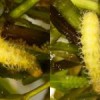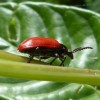 El árbol melaleuca es una planta leñosa invasiva, nativa de Australia, Nueva Guinea, y las Islas Salomón. La melaleuca, conocida también como el árbol de corteza de papel, cajeput, punk tree, o árbol de cepillo blanco, fue introducida en Florida al final del siglo 19 pero aparentemente no se naturalizó hasta el año 1906. La melaleuca fue sembrada extensivamente como un árbol ornamental, y eventualmente invadió los humedales con y sin bosques en el sur de Florida formando monocultivos densos. This 5-page fact sheet is the Spanish language version of Melaleuca Snout Beetle, Melaleuca Weevil (unofficial common names), Oxyops vitiosa (Pascoe) (Insecta: Coleoptera: Curculionidae), written by J.P. Cuda, S.A. Wineriter, G.R. Buckingham, T.D. Center, and K.T. Gioeli, and published by the UF Department of Entomology and Nematology, December 2014.
El árbol melaleuca es una planta leñosa invasiva, nativa de Australia, Nueva Guinea, y las Islas Salomón. La melaleuca, conocida también como el árbol de corteza de papel, cajeput, punk tree, o árbol de cepillo blanco, fue introducida en Florida al final del siglo 19 pero aparentemente no se naturalizó hasta el año 1906. La melaleuca fue sembrada extensivamente como un árbol ornamental, y eventualmente invadió los humedales con y sin bosques en el sur de Florida formando monocultivos densos. This 5-page fact sheet is the Spanish language version of Melaleuca Snout Beetle, Melaleuca Weevil (unofficial common names), Oxyops vitiosa (Pascoe) (Insecta: Coleoptera: Curculionidae), written by J.P. Cuda, S.A. Wineriter, G.R. Buckingham, T.D. Center, and K.T. Gioeli, and published by the UF Department of Entomology and Nematology, December 2014.
http://edis.ifas.ufl.edu/in1020
Tag: J. P. Cuda
Hydrilla leafcutter moth (unofficial common name) Parapoynx diminutalis Snellen (Insecta: Lepidoptera: Crambidae)
 Parapoynx diminutalis Snellen is an adventive Asian moth with an aquatic larval stage. The moth is found associated with a variety of water bodies including river backwaters, lakes, and ponds. The aquatic larvae commonly attack hydrilla and other aquatic plants. The moth was identified in 1971 in India and Pakistan during scouting trips to attempt to determine potential biological control agents for hydrilla. Despite having potential for hydrilla destruction, the moth was declared to be a generalist feeder and unsuitable for release into U.S. water bodies for hydrilla control. But the moth was later found in Florida in 1976 by United States Department of Agriculture technicians who were testing herbicides for hydrilla control. The larvae found on hydrilla were observed to be eating the invasive weed. The pathway, method, or time of the moth’s arrival remains unknown. This 5-page fact sheet was written by Julie Baniszewski, Emma N.I. Weeks, and James P. Cuda, and published by the UF Department of Entomology and Nematology, January 2014.
Parapoynx diminutalis Snellen is an adventive Asian moth with an aquatic larval stage. The moth is found associated with a variety of water bodies including river backwaters, lakes, and ponds. The aquatic larvae commonly attack hydrilla and other aquatic plants. The moth was identified in 1971 in India and Pakistan during scouting trips to attempt to determine potential biological control agents for hydrilla. Despite having potential for hydrilla destruction, the moth was declared to be a generalist feeder and unsuitable for release into U.S. water bodies for hydrilla control. But the moth was later found in Florida in 1976 by United States Department of Agriculture technicians who were testing herbicides for hydrilla control. The larvae found on hydrilla were observed to be eating the invasive weed. The pathway, method, or time of the moth’s arrival remains unknown. This 5-page fact sheet was written by Julie Baniszewski, Emma N.I. Weeks, and James P. Cuda, and published by the UF Department of Entomology and Nematology, January 2014.
http://edis.ifas.ufl.edu/in1024
Florida's Established Arthropod Weed Biological Control Agents and Their Targets (ENY853/IN779)
 Around 5% of the plant species deliberately introduced into Florida for crop production and horticultural uses have invaded sensitive aquatic and terrestrial natural areas as well as improved pastures. One of the reasons they become invasive is they lack the natural enemies that limit their reproduction. Biological control reunites these natural enemies (usually arthropods) with their host plants to selectively weaken and suppress the invasive weeds. This 3-page fact sheet was written by J. P. Cuda and J. H. Frank, and published by the UF Department of Entomology and Nematology, October 2013.
Around 5% of the plant species deliberately introduced into Florida for crop production and horticultural uses have invaded sensitive aquatic and terrestrial natural areas as well as improved pastures. One of the reasons they become invasive is they lack the natural enemies that limit their reproduction. Biological control reunites these natural enemies (usually arthropods) with their host plants to selectively weaken and suppress the invasive weeds. This 3-page fact sheet was written by J. P. Cuda and J. H. Frank, and published by the UF Department of Entomology and Nematology, October 2013.
http://edis.ifas.ufl.edu/in779
ENY853/IN779 Florida’s Established Arthropod Weed Biological Control Agents and Their Targets
ENY853, a 3-page fact sheet by J. P. Cuda and J. H. Frank, describes the role of biological control agents in controlling nonnative invasive weeds, lists the arthropod bilogical control agents that are established for seven invasive weeds, and provides links to additional resources. Includes references. Published by the UF Department of Entomology and Nematology, September 2009.
http://edis.ifas.ufl.edu/IN779
EENY462/IN831 Alligatorweed flea beetle Agasicles hygrophila Selman and Vogt (Coleoptera: Chrysomelidae: Halticinae)
EENY462, a 4-page illustrated fact sheet by Ted D. Center, James P. Cuda, and Michael J. Grodowitz, is part of the Featured Creatures collection. It describes this beetle that was the first insect ever studied for biological control of an aquatic weed — distribution, description, life cycle and biology, host, and economic importance. Includes references. Published by the UF Department of Entomology and Nematology, October 2009.
http://edis.ifas.ufl.edu/IN831